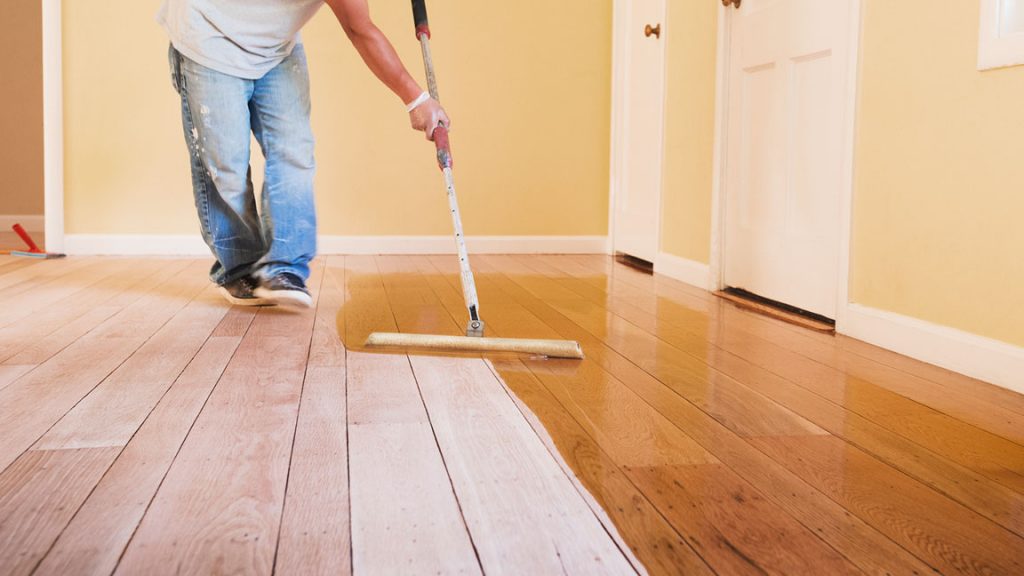Prefinished hardwood flooring comes already sanded, stained, and sealed, saving time and labor during installation. Unfinished hardwood requires on-site finishing, offering more customization options but requiring additional time and effort. Ultimately, the choice depends on preferences for convenience, customization, and budget.
Prefinished hardwood flooring first entered the market in the early 20th century, around the 1920s. This innovation aimed to streamline the installation process by providing factory-finished hardwood planks, eliminating the need for on-site sanding, staining, and sealing.
Unfinished hardwood flooring has been available for much longer, as it represents the traditional method of installing hardwood floors. Before prefinished options became popular, unfinished hardwood was the standard choice, requiring finishing on-site by skilled craftsmen.
Pre Finished Hardwood Flooring
This type of flooring offers several advantages, including convenience and time-saving benefits during installation. With prefinished hardwood, you can avoid the inconvenience of waiting for finishes to dry, allowing for immediate use of the space.
Pros
- Convenience: Prefinished hardwood eliminates the need for on-site finishing, reducing project timelines and minimizing disruptions.
- Time-saving during installation: Since prefinished planks are ready for installation upon arrival, the overall installation process is expedited.
- Consistency in finish quality: Factory-controlled finishing processes result in uniform color and sheen levels throughout the flooring.
Cons
- Limited customization options: Prefinished hardwood offers fewer opportunities for customization compared to unfinished flooring.
- Potential for visible seams: While manufacturers take measures to minimize seam visibility, prefinished flooring may still exhibit visible seams between planks.
Popular applications: Prefinished hardwood flooring is commonly used in residential and commercial settings, including homes, offices, and retail spaces, where convenience and efficiency are prioritized.

Unfinished Hardwood Flooring
Unfinished hardwood flooring, also known as site-finished flooring, arrives in its raw state and requires sanding, staining, and sealing on-site. While this option demands more time and effort during installation, it provides greater flexibility for customization, making it a preferred choice for many homeowners and contractors.
Pros
- Greater customization possibilities: Unfinished hardwood allows for customization of stain color, sheen level, and finish type to suit specific design preferences.
- Seamless appearance when finished on-site: On-site finishing ensures a seamless look across the entire floor, minimizing the visibility of seams between planks.
- Ability to match existing flooring: Unfinished hardwood offers the flexibility to match the color and finish of existing hardwood flooring in the space, achieving a cohesive look.
Cons
- Requires additional time and labor for finishing: Finishing unfinished hardwood flooring on-site adds time and labor to the installation process, delaying the project’s completion.
- Potential for variations in finish quality: On-site finishing may result in inconsistencies in color, sheen, or finish quality if not executed properly.
Unfinished hardwood flooring is commonly chosen for residential renovations, restoration projects, and custom-designed spaces where customization and seamless integration with existing flooring are essential.

Cleaning
Cleaning prefinished and unfinished hardwood floors requires similar care but with slight differences due to their finishes. For prefinished hardwood, regular sweeping or vacuuming with a soft-bristled attachment helps remove dirt and debris.
Damp mopping with a manufacturer-approved hardwood floor cleaner keeps the surface clean without causing damage to the finish. Avoid using excessive water or harsh cleaning agents to prevent potential damage to the finish.
Unfinished hardwood floors require extra caution during cleaning, as they are more susceptible to moisture penetration.
Dry sweeping or vacuuming is recommended to remove surface debris, followed by a slightly dampened mop with a mild hardwood floor cleaner. It’s crucial to avoid excessive moisture exposure and to promptly wipe up any spills to prevent damage to the wood.
Beveld, edges, and groove
Prefinished hardwood flooring can come without beveled edges and grooves. While some prefinished hardwood options feature beveled edges and grooves to add texture and depth to the flooring, there are also options available with straight, square edges for a seamless look. Prefinished hardwood without beveled edges and grooves provides a smooth and uniform.
Unfinished hardwood flooring typically does not come with beveled edges and grooves. Instead, it arrives in its raw state, with straight, square edges.
Because unfinished hardwood requires on-site finishing, the installation process allows for customization to suit specific design preferences, including the option to add beveled edges or grooves if desired. However, by default, unfinished hardwood is typically installed with straight edges, providing a clean and seamless look.
Cost
Prefinished hardwood flooring tends to have a higher upfront cost compared to unfinished hardwood due to the additional manufacturing processes involved in prefinishing the wood.
However, prefinished hardwood can often save money in the long run due to reduced labor costs during installation. Homeowners and contractors can save on expenses such as sanding, staining, and sealing, as these processes are completed at the factory.
Unfinished hardwood flooring generally has a lower upfront cost compared to prefinished hardwood because it lacks the factory-applied finish.
However, the total cost of unfinished hardwood may be higher when factoring in the additional expenses associated with on-site finishing. Homeowners or contractors must budget for the cost of sanding, staining, and sealing the wood, as well as the labor required to complete these processes.
Which of the flooring options is better
Choosing between prefinished and unfinished hardwood flooring ultimately depends on your priorities and project requirements. Prefinished hardwood offers convenience and consistency, as it comes ready for installation with a factory-applied finish.
On the other hand, unfinished hardwood provides greater customization options, allowing you to achieve a tailored look to match your design preferences. Consider factors such as timeline, budget, desired customization, and maintenance preferences when making your decision.
Whether you prioritize ease of installation or the ability to personalize your flooring, both options offer distinct advantages to enhance the beauty and functionality of your space.
Read More
Which is quiter vinyl, carpet, hardwood and laminate flooring comparison
Floating Solid Hardwood Floor Over Concrete





